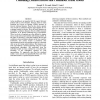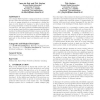26 search results - page 5 / 6 » Predicting Students' Performance with SimStudent: Learning C... |
UMUAI
2008
13 years 5 months ago
2008
Abstract. Self-efficacy is an individual's belief about her ability to perform well in a given situation. Because selfefficacious students are effective learners, endowing int...
AAAI
2011
12 years 6 months ago
2011
Action modeling is an important skill for agents that must perform tasks in novel domains. Previous work on action modeling has focused on learning STRIPS operators in discrete, r...
ICMI
2009
Springer
14 years 16 days ago
2009
Springer
One of many skills required to engage properly in a conversation is to know the appropiate use of the rules of engagement. In order to engage properly in a conversation, a virtual...
CE
2007
13 years 6 months ago
2007
The two separate projects described have examined how teachers exploit computer-based technologies in supporting learning of science at secondary level. This paper examines how pe...
ICRA
2005
IEEE
13 years 11 months ago
2005
IEEE
— Imitation is a powerful mechanism for transferring knowledge from an instructor to a na¨ıve observer, one that is deeply contingent on a state of shared attention between the...


